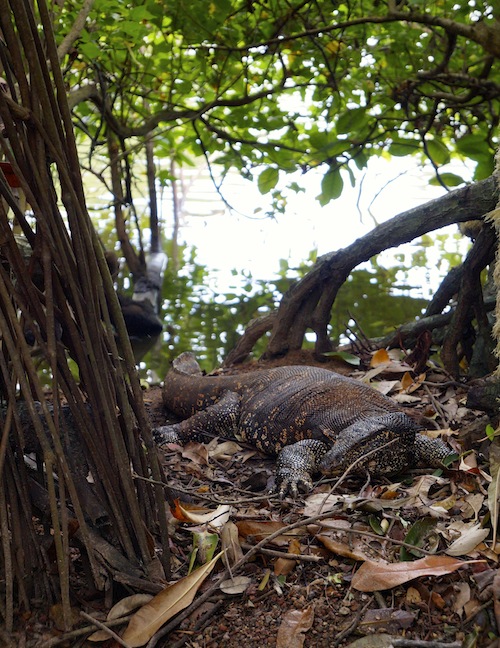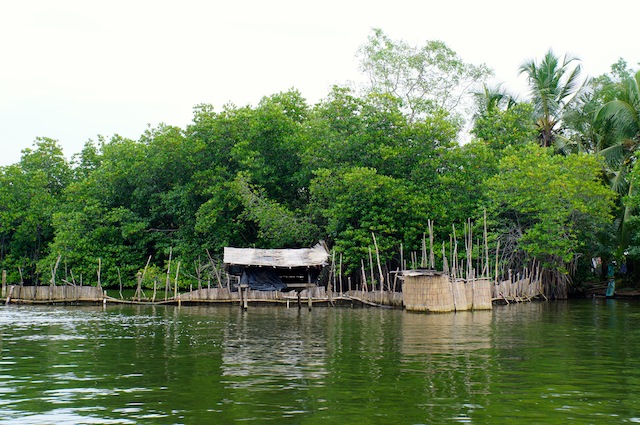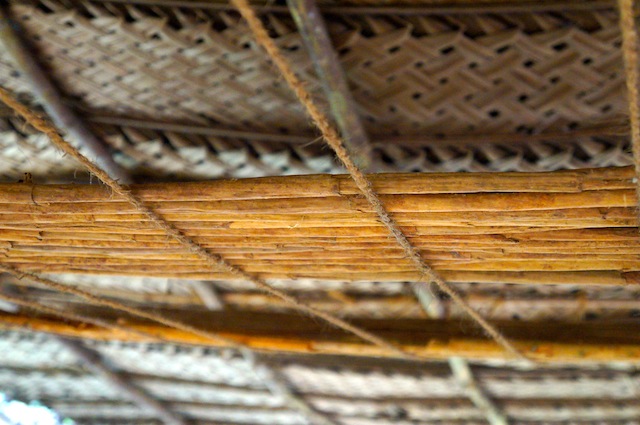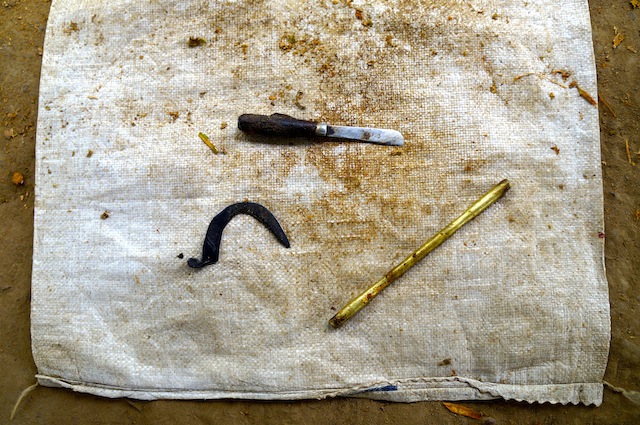BY LAUREN RAYNER
The bark fell in shavings onto the mat; dark and leathery, like skin. The old man dropped the blade he was using, swept the shavings into his fist and tossed them aside. “Compost,” he said.
He picked up a brass bar and began massaging the stick in his hand. The inner bark flexed, loosened imperceptibly in his grasp. He took a small crooked knife, a kokaththa, and with a surgeon’s precision, marked two parallel slits in the bark. In one deft movement, he eased the layer free from the twig. Satisfied, he tossed the twig onto another pile. “Firewood.”

He took the precious layers of inner bark in his fingers, and wrapped them within each other in plies, until he had crafted a quill about a foot long. He stood, slotted the quill in the strings of coir hanging beneath his coconut-leaf roof, and said, “Eight days.” He patted the quills that had already grown dark and brittle in the shade. “No sunlight.”
In eight days’ time, the old man’s son will collect the quills, cut them to the specified lengths, and seal them in bags to be sold in the market. After which, these little finger-sized quills will be found in the curries, cakes and teacups of villagers throughout this rural corner of Sri Lanka.
The cinnamon peeler’s life is a simple one. Vidurasena Mama (meaning “uncle”) and his family are the only inhabitants of this small island in the Madu Ganga, Sri Lanka’s second largest wetland reserve. They make their living from the plant that grows freely here ““ their island, Kurundu Doowa, is named for it: “Cinnamon Island”. It is a traditionally lucrative profession, but Vidurasena’s home is modest. He shares a small bungalow with his children, grandchildren and wife, who, when I visited, was hanging the laundry to dry on the branches of a cashew tree.

I had stopped at the island during a river safari along the Madu Ganga (ganga means “river” in Sinhala), a 915-hectare wetland reserve in Sri Lanka’s southwest region. Our little boat cruised from Balapitiya down narrow tracts of mangrove forests that opened out to a vast expanse of water ““ home to some 70 species of fish and 31 species of reptiles, including the languid-eyed water monitor and some crocs.
The Madu Ganga’s mangrove tracts meander through natural caves and around islets, eventually flushing out to the sea at Balapitiya. Here occurs what Sri Lankans call the “river’s secret”: in the mornings, the tide comes inland to mix seawater with the freshwater of the Madu Ganga, and recedes in the evening, taking the river water out to sea.
The resulting water forms a sanctuary for many species of Sri Lanka’s flora and fauna, and the thick mangrove growth creates a “bio-lock”, protecting the ecosystem within. Cinnamon, bamboo and coconut trees grow with abandon among the Madu Ganga’s 25 islands. The kingfisher, black stork, pond heron and green bee-eater flit around freely. Enormous lizards laze on rocks, absorbing the heat of Sri Lanka’s afternoons.

The scent of cinnamon was unmistakeable from the second I set foot on Kurundu Doowa, released as cinnamon leaves were crunched underfoot. Vidurasena makes oil from these leaves, distilled with quillings (cinnamon quill chips) and roots. He handed me a small vial of cinnamon oil. “For mosquitoes!” He said. “And headache, toothache, nose block.” There is no end to the benefits of the cinnamon tree. I took the vial of oil to my nose. It smelled like Christmas.
Sri Lankan cinnamon ““ kurundu ““ has been enjoyed since antiquity for its delicate flavour. A 17th century Dutch captain is said to have claimed that Sri Lankan cinnamon is the best in all the Orient: “When one is downwind of the island, one can still smell cinnamon eight leagues out to the sea.” Exaggeration though that may be, the perfumed air of the Madu Ganga is intoxicating.
The wetland is home to some 215 families, many of who continue to make a living as their ancestors had for centuries before. As well as cinnamon, fruit and coconuts are cultivated; rope makers extract coir from coconut husks to make rope; and the thatched bamboo hedges of prawn farms punctuate the river. These prawn farms are an important Madu Ganga industry: locals claim prawns from these waters taste better than any other due to the conditions caused by the “river’s secret”. Farmers use kerosene lamps to attract prawns to simple bamboo baskets submerged in the river; sticks of bamboo rise from the water, keeping the traps in place. Invariably, a kingfisher keeps watch on top.

Among the mangroves grows the kaduru, a fruit-bearing tree whose light wood is used for the making of traditional Sri Lankan masks. These terrifying, brightly coloured faces are still used in some traditional communities for ceremonial dances to ward off illness and evil. The nearby town of Ambalangoda is famed for its mask workshops, each bursting with the wide eyes and dazzling colour of demons.
But within the fertile ecosystem of the Madu Ganga, danger also lurks. As we glided past the kaduru trees in our boat, my guide, Thushara, pointed out its bulbous green and orange fruit. “If a man wanted to commit suicide,” he said. “He would mix its seeds with sugar and drink it.”
Nearby, a man bathed in the opaque water by an enclosure of bobbing coconuts soaking for their coir. “What about crocodiles?” I asked in alarm, pointing to the man casually scrubbing his underarms.
Thushara shrugged. “No attacks have been reported yet.” His “yet” lingered in the cinnamon-scented air.
But the Madu Ganga’s most terrifying threat is not reptilian. The 2004 tsunami devastated Sri Lanka’s coastline. Driving down from Bentota earlier that day I had passed the ruined shells of countless former homes; eight years on, recovery was not complete. After the tsunami, a rehabilitation project was implemented to re-establish people displaced by the disaster and to replant mangrove forests that had been destroyed.
The future is brighter: tourism in Sri Lanka has been steadily increasing since the civil war ended in 2009, and many travellers are drawn to the gold-soaked beaches of the south west region. The main resort towns have been rebuilt (if a little too close to the water) and subsequently, the economic conditions of the local people are improving.

As we returned through the mangrove tracts, a traditional oruwa boat glided silently past us. On its bow, a tightly-bound bale of cinnamon rested. Soon it would fragrance the curries, cakes and teas of the families of Sri Lanka, perhaps beyond. Its scent coiled around us in tendrils of sweetness, before drifting out to sea.
The Captain, Pradeep Chandana de Silva, runs riverboat safaris daily at Gangabada Asiriya, Bridge View, Custom Road, Balapitiya. Tel: +94 91 225 7614. The writer travelled with Real Holidays, which organises tailor made Sri Lanka itineraries including Madu Ganga river safaris. Tel: +44 207 359 3938.
 ABOUT THE WRITER
ABOUT THE WRITER
Lauren is a travel writer, blogger and social media strategist in the travel industry. Australian born and London based, Lauren prefers to be kept on her toes (both literally and figuratively), travelling the globe whenever she can. Follow Lauren on Twitter @LaurenKRayner.
All photos by Lauren Rayner




